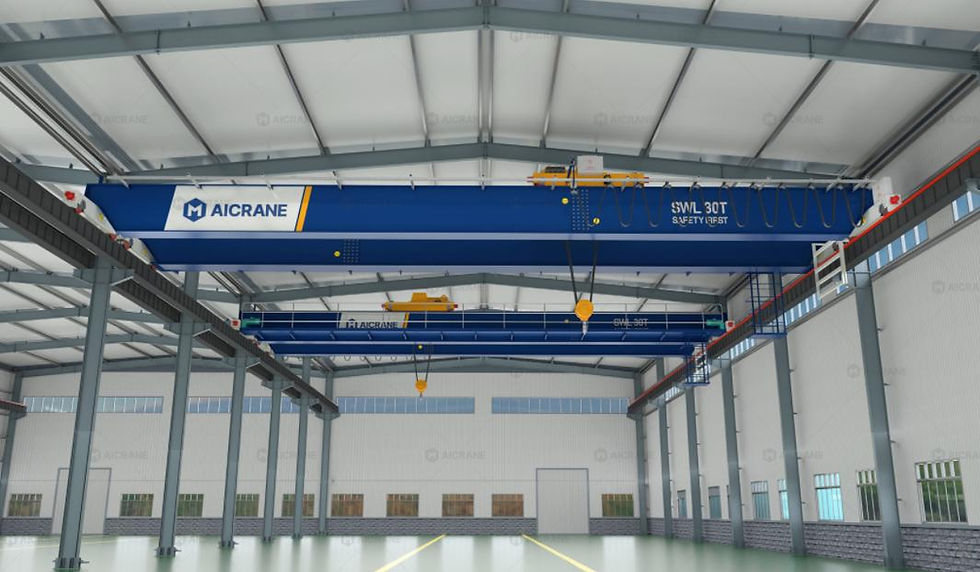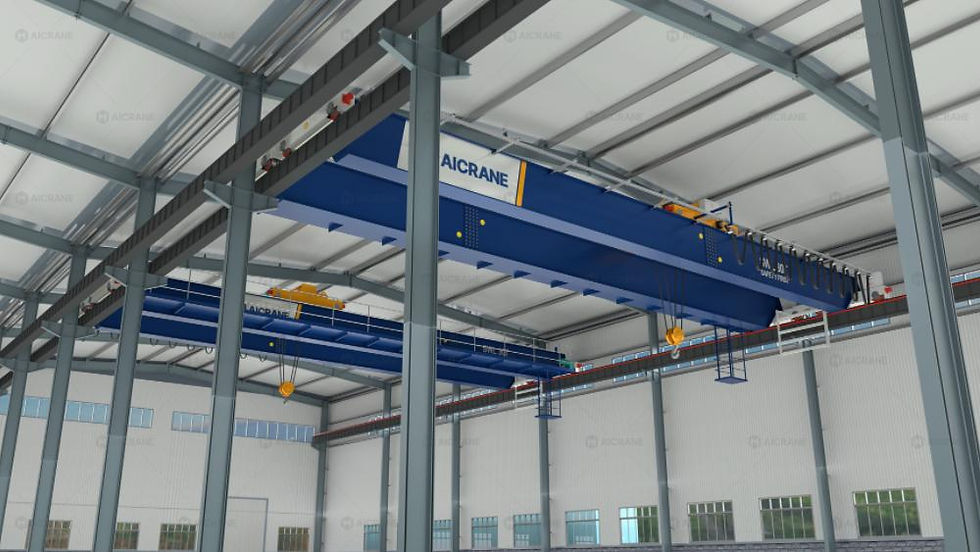Common Misconceptions About 30 Ton Overhead Crane Capacity
- charlespsnow
- Aug 24, 2025
- 5 min read
When industries invest in a 30-ton overhead crane, they expect a reliable lifting solution capable of handling heavy-duty loads safely and efficiently. However, many misconceptions exist regarding what a crane’s “capacity” really means and how it should be interpreted in daily operations. Misunderstandings about overhead crane capacity can lead to overloading, safety risks, operational inefficiencies, or unnecessary expenses. In this article, we will examine the most common misconceptions about 30-ton overhead crane capacity, clarify the realities, and provide best practices for ensuring safe and productive crane use.

Misconception 1: A 30-Ton Crane Can Lift 30 Tons Anywhere Along the Span
One of the most frequent misunderstandings is assuming that a 30 ton overhead crane can safely lift 30 tons at any point along the bridge span. In reality, capacity is often rated at the most favorable position—usually near the center of the span, directly under the hoist.
The truth: The crane’s load capacity is calculated based on structural design, deflection limits, and load distribution. While the crane can typically handle its full rated load across most of its span, certain conditions (such as when the load is off-center or near the end stops) can reduce safe lifting capacity.
Why it matters: Operators must avoid assuming uniform lifting ability and instead follow the load charts or manufacturer guidelines for load placement.
Misconception 2: The Crane’s Rated Capacity Includes All Attachments
Another misconception is that the full 30-ton capacity refers only to the lifted material. Many users forget that below-the-hook lifting devices such as spreader beams, magnets, tongs, or lifting clamps also count toward the total load.
The truth: If a lifting beam weighs 2 tons and the load weighs 29 tons, the crane is technically overloaded because the combined weight exceeds 30 tons.
Why it matters: Operators must always account for the weight of rigging, slings, hooks, and lifting devices in addition to the material being lifted.
Misconception 3: Capacity Ratings Never Change Over Time
Many facility managers believe that once a crane is rated at 30 tons, it will always safely lift that weight for its entire service life. However, wear and tear, corrosion, fatigue, and component aging can reduce safe working capacity over time.
The truth: A crane’s original capacity is based on ideal conditions at installation. Over years of service, its structural integrity and mechanical performance may degrade, requiring de-rating or reinforcement.
Why it matters: Regular inspections, maintenance, and load testing are essential to verify that the crane continues to safely handle its rated capacity.
Misconception 4: Overhead Cranes Can Be Overloaded Occasionally Without Issue
Some operators mistakenly assume that exceeding rated capacity “just once” will not cause significant harm. They may argue that a crane with a 30-ton rating can temporarily lift 32 or 33 tons in urgent situations.
The truth: Overloading can cause immediate mechanical damage, accelerate fatigue, or lead to catastrophic failure. Even one-time overloads can compromise the crane’s structural safety.
Why it matters: Cranes are engineered with specific safety factors, but they should never be intentionally overloaded. Consistent adherence to rated limits protects both equipment and personnel.

Misconception 5: A 30-Ton Overhead Crane Can Handle Any Type of Load Up to 30 Tons
Not all loads are the same. While a crane may safely lift a 30-ton uniform block of steel, lifting 30 tons of long, unbalanced, or shifting material presents additional challenges.
The truth: Load configuration, center of gravity, and stability significantly impact lifting safety. A 30-ton unbalanced beam could create side-loading on the crane structure and trolley, exceeding design limits.
Why it matters: Operators must consider load shape and stability, not just total weight, when planning lifts. Additional rigging or spreader bars may be required to ensure balanced and safe lifting.
Misconception 6: Crane Capacity Is the Same as Hoist Capacity
Some people assume that if a crane is rated at 30 tons, every component—including the hoist, trolley, bridge girders, and end trucks—is rated equally. In practice, ratings can differ.
The truth: While the hoist may be rated for 30 tons, the supporting structure might have slightly different design limits, and the weakest link determines overall safe capacity.
Why it matters: Users must always treat capacity as the rating of the system as a whole, not just one component.
Misconception 7: Adding More Power Increases Capacity
A common belief is that installing a more powerful hoist motor or upgrading drives allows the crane to lift heavier loads.
The truth: Overhead crane capacity is determined primarily by the structural design of girders, end trucks, and runway beams—not just motor strength. Simply upgrading a motor without reinforcing structural elements does not increase safe lifting capacity.
Why it matters: Unauthorized modifications can create dangerous mismatches between mechanical power and structural limits. Capacity upgrades should always be done under professional engineering review.
Misconception 8: Safety Factors Mean You Can Safely Exceed Capacity
Some operators believe that because cranes are engineered with safety margins, it is acceptable to exceed capacity slightly.
The truth: Safety factors exist to protect against unexpected stresses, material imperfections, or dynamic effects—not to allow intentional overloading. Relying on safety margins undermines engineering safeguards.
Why it matters: Safe crane operation requires strict adherence to rated limits. Safety margins should remain an invisible buffer, not an operational tool.
Misconception 9: Crane Capacity Is the Only Factor in Safe Operation
Many assume that as long as the crane capacity exceeds the load, the lift is automatically safe. In reality, capacity is only one part of safe lifting.
The truth: Factors such as ground support, runway beam strength, operator training, wind conditions, and rigging methods all affect lifting safety. A properly rated crane can still be involved in accidents if other conditions are ignored.
Why it matters: Safe crane use requires holistic planning that goes beyond weight alone.
Misconception 10: Load Testing Proves the Crane Can Always Lift Its Rated Capacity
Some facilities think that if a crane passes its annual load test, it is guaranteed to handle 30 tons under any circumstances.
The truth: Load testing verifies performance under controlled conditions, not in every real-world scenario. Environmental factors, side pulls, or wear that develops after testing can still impact safe capacity.
Why it matters: Load tests should be seen as one piece of a comprehensive safety program, not as absolute proof of capability.
Best Practices to Avoid Misconceptions
To ensure safe and efficient use of a 30-ton overhead crane, companies should adopt the following practices:
Train operators and riggers on capacity concepts, load charts, and the impact of rigging devices.
Account for total load weight, including attachments and rigging.
Schedule regular inspections to identify wear and de-rating needs.
Avoid overloads at all times, even for short lifts.
Use proper rigging techniques to maintain load balance and stability.
Consult manufacturers or engineers before making any modifications or upgrades.
Incorporate capacity awareness into daily safety checklists and job planning.
Conclusion
A 30-ton overhead crane is a powerful piece of equipment, but its rated capacity is often misunderstood. Misconceptions—such as assuming uniform lifting ability, ignoring attachment weights, or believing that safety factors justify overloads—can put workers and assets at risk. By understanding the true meaning of crane capacity and implementing best practices, industries can maximize productivity while maintaining the highest safety standards. Ultimately, knowledge and vigilance are the keys to preventing costly mistakes and ensuring that a 30-ton crane performs reliably throughout its service life.










Comments